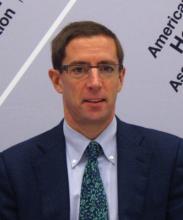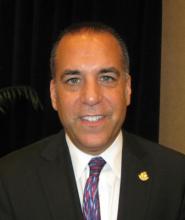LOS ANGELES – An endothelin receptor antagonist that showed promise in phase II clinical trials did not significantly reduce vasospasm-related morbidity and mortality in a phase III study of 1,147 patients treated with surgical clipping for aneurysmal subarachnoid hemorrhage.
Six weeks after randomization in the international, multicenter trial, 21% of 764 patients on the investigational drug clazosentan died or had vasospasm-related complications, compared with 25% of 383 patients on placebo, a nonsignificant difference, Dr. Robert Loch Macdonald reported at the International Stroke Conference.
The primary measure was a composite outcome of death from any cause within 6 weeks (5% in each group died), new cerebral infarct (in 12% on clazosentan and 13% on placebo), vasospasm-related neurological deterioration (in 15% and 18%, respectively), and the need for rescue therapy (in 11% and 16%, respectively).
Functional outcomes at 12 weeks also appeared to be no better in the clazosentan group than in the placebo group in the CONSCIOUS-2 trial (Clazosentan to Overcome Neurological Ischemia and Infarct Occurring After Subarachnoid Hemorrhage). In the treated group, 29% had a Glasgow Outcome Scale score of 4 or lower (indicating poor outcome), compared with 25% of the placebo group, a statistically insignificant difference, said Dr. Macdonald, head of neurosurgery at the University of Toronto.
Rates of adverse events were higher in the clazosentan group than with placebo, but investigators did not analyze these differences for statistical significance, he said at the conference, sponsored by the American Heart Association.
Lung complications occurred in 34% on clazosentan and 18% on placebo. In the clazosentan group, 13% had lung complications related to pulmonary edema, 22% developed anemia, 20% had hepatobiliary events, 12% developed hypotension, and 4% had a cerebral hemorrhage. In the placebo group, lung complications related to pulmonary edema were seen in 7%, 15% developed anemia, 17% had hepatobiliary events, 4% developed hypotension, and 3% had a cerebral hemorrhage.
A subgroup analysis suggested that patients who were sicker or who had more bleeding from the aneurysm may have benefited from the drug more than other patients, Dr. Macdonald said.
A separate CONSCIOUS-3 trial of clazosentan versus placebo in patients after treatment with endovascular coiling of aneurysmal subarachnoid hemorrhage was stopped once the CONSCIOUS-2 results were known. The results of CONSCIOUS-3 should be available in a few months. "Then we’ll decide whether to pursue the drug for those subgroups I mentioned, try to manage those side effects, or not develop the drug further," Dr. Macdonald said.
Previous optimism about clazosentan from the phase II clinical trial, CONSCIOUS-1, came from a significant reduction in vasospasm in the drug-treated group compared with placebo, not from measures of patient outcomes (Stroke 2008;39:3015-21).
It may be that CONSCIOUS-2 was too small, or didn’t measure the right outcomes, or the outcomes were affected by the adverse events, he said. "My other hypothesis at this point is that the angiographic vasospasm is only part of the phenomenon that causes stroke. If you get rid of the vasospasm, you don’t get rid of all of the things that cause stroke, and since you don’t do that, the person doesn’t get better."
Other strategies in trials to reduce vasospasm-related problems after treatment of aneurysmal subarachnoid hemorrhage include statin therapy or higher doses of nimodipine to avoid hypotension. "Those might be the way to go instead of drugs that only target dilating arteries," he said.
In a press briefing, Dr. Ralph Sacco, president of the American Heart Association, said that clazosentan is not the first investigational drug to show promise in phase II clinical testing and then be disappointing in a phase III trial.
"Subarachnoid hemorrhage is a very important, devastating type of stroke. We are still hopeful that we will have other medications in the future that will be helpful for delaying vasospasm and reducing morbidity with subarachnoid hemorrhage" besides currently available nimodipine, said Dr. Sacco, who also is professor of neurology and chair of neurological diseases at the University of Miami.
Vasospasm generally is more of a problem after surgical clipping than after endovascular coiling of aneurysms in patients with subarachnoid hemorrhage, so it’s possible that the CONSCIOUS-3 results differ somewhat from those of CONSCIOUS-2, Dr. Sacco said in a separate interview. "Coiling is also becoming much more frequently used among patients, both internationally and in the United States, for treatment of aneurysms."
Actelion Pharmaceuticals, which is developing clazosentan, funded the study and has provided research support to Dr. Macdonald. He also has been a consultant to the company and has ownership in Edge Therapeutics, a company that is developing drugs for subarachnoid hemorrhage. Dr. Sacco said he has no relevant conflicts of interest and was not involved in the CONSCIOUS-2 study.



